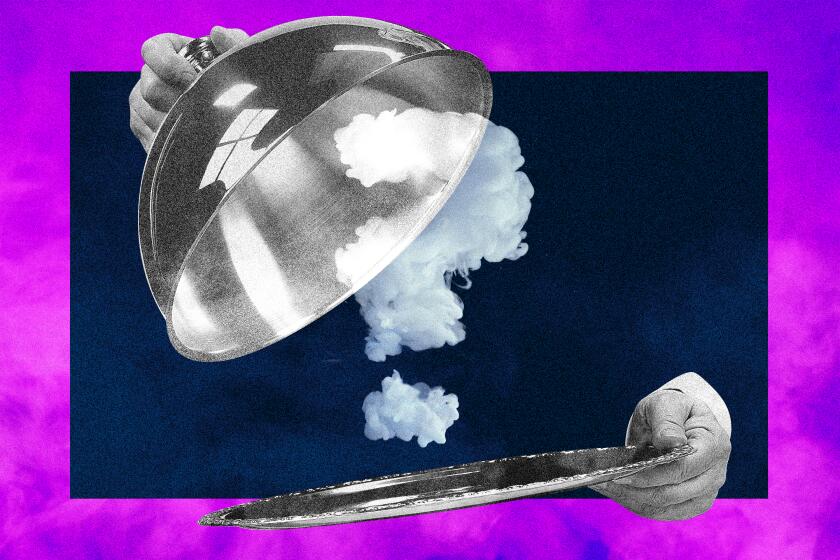Youths’ nitrous oxide use has adults taking action
For months, parents in Diana del Pozo-Mora’s Boyle Heights neighborhood had been hearing that children -- some as young as 11 and 12 -- had passed out at school after inhaling “whippets,” small canisters of nitrous oxide.
Recently, Del Pozo-Mora, the mother of three, was shocked when she saw an older boy buy a whippet canister from an ice cream truck parked outside a local elementary school.
Intended for home use to make whipped cream, whippets are among the inhalants of choice among Los Angeles students, including middle-schoolers whose use of inhalants now outpaces marijuana use, surveys show.
In response to reports from schools and law enforcement of increasing incidents, Assemblyman Tom Torlakson (D-Antioch) introduced legislation that would prohibit the sale or distribution of nitrous oxide, including whippets, to anyone under 18. The bill, AB 1015, has passed the Senate Public Safety Committee and is scheduled for a floor vote in August.
Experts say a number of today’s teens are abusing a wide variety of household products -- some 1,400 have been identified -- many of which have no odor and are hard to detect, said local and national authorities. Additionally, education campaigns that had been effective in reducing abuse have waned in recent years, they said.
Many experts now view inhalants as the gateway drug for pre-adolescent and young teenagers who then move on to experimenting with harder substances. A 2008 report by the federal Substance Abuse and Mental Health Services Administration found inhalants were more commonly used among 12- and 13-year-olds than marijuana and prescription drugs.
A 2007 California Healthy Kids Survey found that 17% of seventh-graders in the Los Angeles Unified School District had abused inhalants, compared with 8% of seventh-graders statewide. (Both percentages were slightly higher than in a previous study.) Meantime, 14% of the Los Angeles students said they had used marijuana.
Recently, three students at Madison Middle School in North Hollywood who allegedly had been abusing inhalants were hospitalized. At Roosevelt High, a student who had allegedly been huffing inhalants lost consciousness and had to be resuscitated.
First-time use of inhalants, which include other gases, aerosols and solvents, can disrupt heart rhythm and result in serious brain damage or death from cardiac arrest or asphyxiation. The phenomenon has been labeled sudden sniffing death syndrome.
Torlakson’s bill exempts nitrous oxide in food products and used for medical and dental care. Several other states have adopted similar legislation, but current California law bans only possession of nitrous oxide with the intent to become intoxicated. The bill has not been opposed by retailers or aerosol manufacturers.
“I was surprised to learn that so large a number of kids were experimenting with these substances where potentially one use can result in death and the brain damage is irreversible,” Torlakson said. “It’s a cheap high and considered cool. The law will help by prohibiting sales but also focusing attention on the problem and creating debate and awareness.”
Some experts say laws banning sales of only one product don’t go far enough, while others urge more emphasis on education and prevention. But officials who helped draft the California legislation said it would be far harder to regulate sales of air fresheners, deodorants and other common items.
Del Pozo-Mora and other Boyle Heights residents created the Boyle Heights Coalition for a Safe and Drug Free Community and decided to focus on inhalant abuse after hearing that it is a problem among local teens. Nitrous oxide canisters are readily available at gas stations and mom-and-pop stores for 50 cents each.
The group, which testified in support of the ban, received a five-year, $625,000 federal grant for the Salesian Boys and Girls Club to educate students and parents about inhalant and other drug dangers.
“The scariest part was going on the Web and every video that popped up was showing how to abuse these substances,” she said. “If we can save one life, that’s important.”
L.A. Unified has launched a prevention campaign and will distribute instruction guides to teachers this fall. Many students view inhalants as less risky than other drugs, said Antonio Roque, an L.A. Unified health education advisor.
“Depending on the amount and method used, the high can last for 30 seconds to three minutes, so the effects are quick and go away, allowing the student to go back to class with no signs,” he said.
But studies have found that inhalants are as addictive as cocaine, said Veronica De Alba, a Los Angeles assistant city attorney who is working with school and police officials. She became concerned when she started hearing from parents that aerosol cans were replacing cigarette butts in local parks. Her office, under then-City Atty. Rocky Delgadillo, sponsored the Torlakson bill.
Police are more alert to inhalant abuse now, said Capt. Paul Hernandez III of the Los Angeles Police Department’s Hollenbeck Division. Officers are checking on nitrous oxide use at large teen parties and looking for suppliers.
They are also mindful of physical evidence, such as in the death over the July 4 weekend of a 20-year-old Boyle Heights man whose closet held multiple cans of a computer dust remover. A preliminary coroner’s report linked the death to inhalant abuse, Hernandez said.
Parents have to educate themselves about what’s dangerous, said Christian Gilmartin. His 16-year-old daughter, Meghan, became addicted to huffing air freshener two years ago as a high school student in San Bernardino. She died in April from the effects of inhalant abuse.
“It blows me away how ignorant people are about this plague,” Gilmartin said. “The lack of education has cost lives.”
--
More to Read
Start your day right
Sign up for Essential California for news, features and recommendations from the L.A. Times and beyond in your inbox six days a week.
You may occasionally receive promotional content from the Los Angeles Times.







